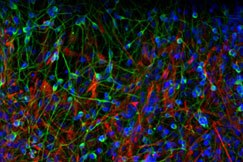Science and technology
SA scientists in stem cell breakthrough
Inducing adult cells to revert to stem cells
According to the council, Dr Janine Scholefield, one of the CSIR researchers involved in generating iPSCs, had recorded video footage of rhythmically beating cells through a microscope. "The beating pattern is distinctive, and easily recognisable as heart muscle cells," the CSIR said. "These cells, however, didn't come from a heart, but were, instead, transformed into heart cells, from skin cells taken from an adult. "This is the basis of iPSC technology, which induces adult cells (like skin cells) to revert back into stem cells, which are cells at the earliest stage of life. These early stem cells can then be programmed to become any type of adult cell, such as skin, heart, brain and blood cells."Vast medical possibilities
The medical possibilities of iPSCs are vast, and include growing new tissue for transplanted into people suffering from various diseases. "It could be used for restoring sight by replacing defective tissue in the eye; transplanting new heart muscle cells into people with serious heart diseases; giving people with anaemia new healthy blood cells; even harnessing brain cells to treat disorders such as Parkinson's disease," the CSIR said. Another way of harnessing the technology is to create "disease-in-a-dish" models, by growing diseased tissue from the stem cells of sick patients. "Since stem cells can be made from a patient's own cells, the cells contain the exact same genetic characteristics as the patient these were taken from, meaning that this tissue will be 'sick' in the same way as the patient."Avoiding ethical controversies
Part of the novelty of the technology lies in the fact that stem cells can be made from almost any individual with almost any disease, simply by taking a skin sample from that person. Another benefit of using iPSCs is that they bypass the ethical controversy surrounding classical stem cells, which must be taken from embryos. Scholefield will be collaborating with Professor Susan Kidson at the University of Cape Town Medical School in developing her models, allowing for the testing of possible cures, or understanding the disease, without having to subject a patient to invasive surgery or untested trial medication.Applying cutting-edge research in Africa
Scholefield spent three years working with international experts at Oxford University in the UK in order to perfect the technique of creating iPSCs. She now forms part of a team of CSIR scientists with expertise in various emerging health technologies, who work to apply this knowledge in an African context. According to Dr Musa Mhlanga, who heads up the CSIR's gene expression and biophysics group, cutting-edge medical research "is not useful to Africa if knowledge is being created and applied only in the developed world. "Given the high disease burden in Africa, our aim is to create knowledge, as well as be innovators and expert practitioners, of the newest and best technologies." Mhlanga's group receives long-term financial support from the Department of Science and Technology. SAinfo reporter
Images of vessels derived from induced pluripotent stem cells (green) (Photo: Rakesh Karmacharya / Harvard Stem Cell Institute)
Related links
Related articles
- Govt, Absa partner on technology
- Nestlé, South Africa partner in science
- New positions to strengthen SA research
- Research to boost rooibos exports
- SA to build more science centres
- Italy, South Africa work on Aids vaccine
- R80m microscope boost for nanoscience
- SA-based scientist in world top 100
- CSIR laser technology a 'world first'




